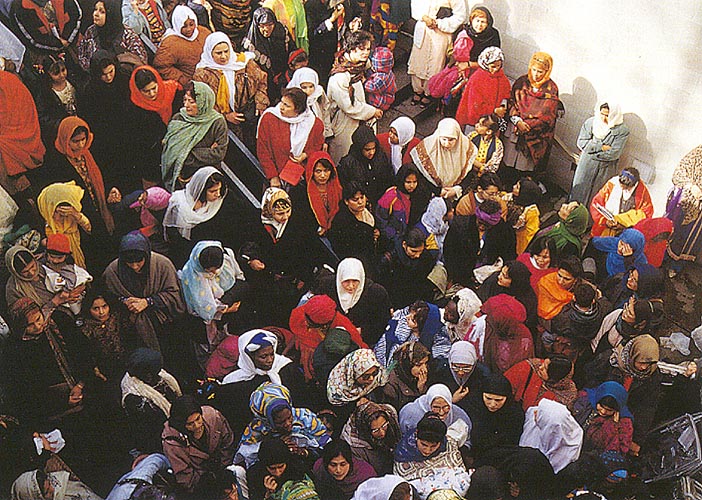
The Veil and Veiling
 |
The study of the veil and veiling is not as simple as whether one veils or does not, whether a culture requires a veil or does not, and whether the veil is oppressive or liberating; it encompasses so much more. Veiling is a complex tradition that is specific to time and place.
We ask you to consider the following questions about the veil:
-Is veiling always oppressive to Muslim women?
-Can the veil be liberating?
-Can it be empowering to see without being seen?
-Is the veil mandated by the Quran?
-Do only women wear veils?
-Is there any tradition of veiling in the West?
This webpage explores the various types of veils, what the veil represents to different Islamic cultures, and how the West perceives the veil.
Misconceptions About Veiling
Many Westerners are obsessed with the veil and view veiling as an antiquated and oppressive tradition forced upon Muslim women. This obsession with the veil has resulted in the following misconceptions:
Misconception: The veil is homogenous
Contrary to popular belief, there are many different kinds of veils. There is no one Arabic word for "veil" and even the English dictionary lists four distinct definitions of the word veil, in terms of material, space, communication, and religion. In regard to Islamic culture, the veil is best viewed as a part of dress in the manner that, like other elements of dress, it is specific to time and space. In different areas of the Islamic world, styles of veiling and reasons for it are distinct. Here are three common types of veils:
 |
a. Hijab- a head scarf that usually is worn for religious reasons. There is not one type or color. |
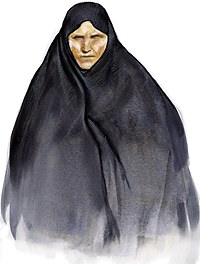 |
b. Chador- a large black shawl that covers the hair and entire body. The chador is most commonly associated with Iran today. |
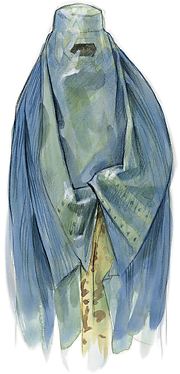 |
c. Burqa- a large robe that covers the entire body, including the head and face, with a mesh covering over the eyes, so its wearer can see and breathe. The burqa is most commonly associated with Afghanistan today. |
For more information about the various types of veils, we suggest: http://seattletimes.nwsource.com/news/nation-world/crisis/theregion/veils.html
Misconception: The Quran states that Muslims have to veil
The Quran does not specifically mandate veiling, but simply speaks about modesty, respect, and the covering of the body. In fact, male modesty is more frequently referred to in the Quran then female modesty. In most Muslim societies veiling is not enforced, but a choice. It is a way for Muslims to outwardly show their devotion and respect for Islam. The following excerpts from the Quran encourage both men and women to embrace modesty in their daily lives out of respect for God, their faith, and each other.
"O Prophet, tell your wives and daughters and the believing women
to draw their outer garments around them (when they go out or are
among men). That is better in order that they may be known (to be
Muslims) and not annoyed..."(Quran 33:59)"Say to the believing man that they should lower their gaze and guard their modesty; that will make for greater purity for them; and Allah is well acquainted with all that they do. And say to the believing women that they should lower their gaze and guard their modesty; and that they should not display their beauty and ornaments except what must ordinarily appear thereof; that they should draw their veils over their bosoms and not display their beauty except to their husbands..."(Quran 24:30-31)
Misconception: The veil eliminates its wearer's identity
Veils do not take away identity, but rather can be markers of identity. They are not only symbolic of faith, but are also a form of visual expression. The veil can reveal many things about its wearer as an individual including:
-where they are from
-tribal association
-status/rank
-the event they are attending such as a wedding or funeral
-marital status
-a woman's skill as a textile maker
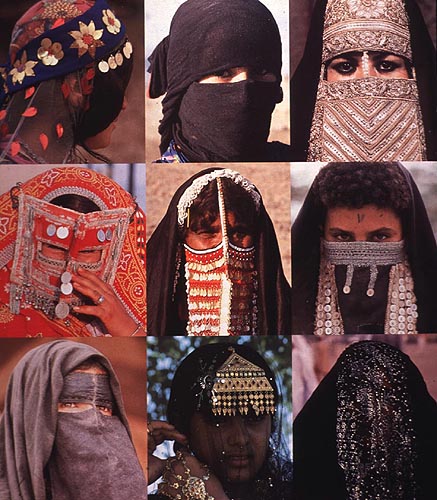 |
The color of a veil, the way a veil is worn, and how decorative it is are forms of expressing cultural identity and self-expression in Muslim society. |
Misconception: Only women wear veils
|
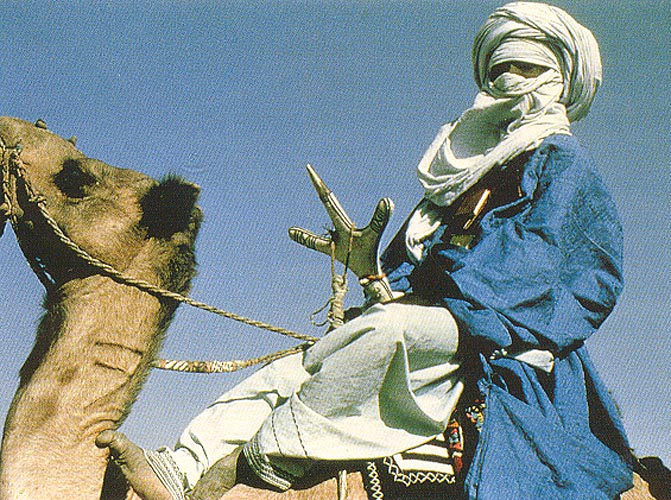 |
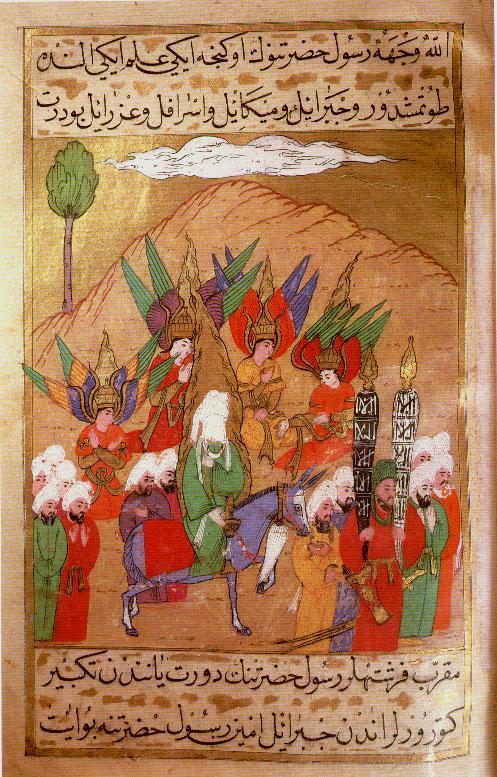 |
|
|
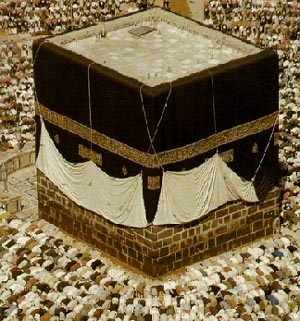 |
"The link between dress...and sanctity of space is reflected in the Islamic rituals of "dressing" the Ka'ba, the center of the holy site of pilgrimage...The correspondence between the sanctuary of the Ka'ba and the home (as sanctuary) is exemplified in the measures for protection and attitudes of protectiveness in both spheres." (Guindi, 95-6).
The veiling of men, Mohammed, and architecture, is further evidence that veiling has many meanings, but it is always sacred.
Misconception: The veil is antithetical to Western tradition
Veiling is not foreign to Western society. Veiling was practiced in Ancient Greece and throughout the Mediterranean before Islam was founded, and is still practiced today in Western societies. For example, brides wear veils, nuns wear veils, and widows often wear veils. Why are Western women who wear veils not considered oppressed? Perhaps because Western women are familiar with their traditions and unfamiliar with Muslim traditions, they view Muslim veiling as completely different.When something is different people choose to see it the way they want to. Westerners have chosen to understand the veil as an oppressive tradition, when in fact, the veil is only oppressive when it is enforced.
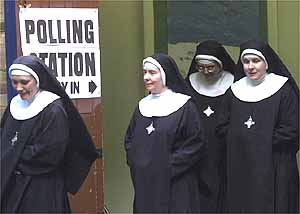 |
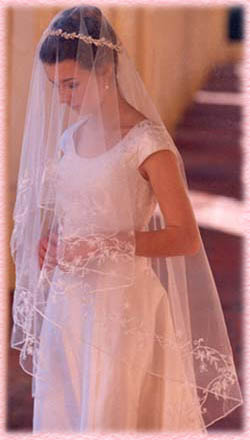 |
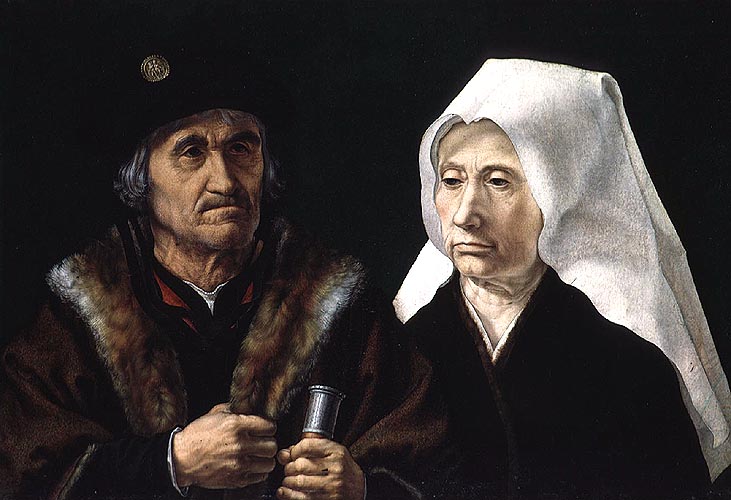 |
Misconception: Women wear veils out of shame
Muslim women do not cover up out of shame. Veiling is about modesty and privacy. In fact, it can be empowering to see without being seen. Westerners often feel a loss of control when they cannot see the women behind their veils. Perhaps some prefer to believe that veiling oppressive so they do not have to acknowledge that it is threatening to them. Yet if people let go of their preconceived notions about the veil it would cease to be the unknown and come to be understood as a part of dress and an expression of identity.
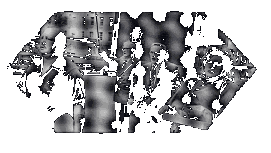 |
The veil acts as a portable home and can give a woman a sense of privacy even if she is in public. This photograph is taken by a woman through her burqa. |
With all of
these misconceptions, how can we
begin to better understand the veil?
"The ability to choose whether to veil or not, in accordance with [Muslims'] own personal interpretation of Islamic faith and morality, is at the very heart of what Islam represents to [Muslims]: the basic Qur'anic ethic of sovereign right of both women and men as human beings who have the freedom of self-determination."
(www.maryams.net/articles_veil01.shtml)
|
1)
Take a look at the CONTEXT in
which the veil is worn 2) See
the veil as a form of DRESS 3)
Consider both GENDERS 4)
Consider the veil as a symbol of MODESTY
and PRIVACY 5)
Look at the veil in terms of GENDERED SPACE |
Quotes from women in North America who choose to veil:
"We want to stop men from treating us like sex objects, as they have always done. We want them to ignore our appearance and to be attentive to our personalities and mind. We want them to take us seriously and treat us as equals and not just chase us around for our bodies and physical looks."
"When a woman is covered, men cannot judge her by her appearance but are forced to evaluate her by her personality, character, and morals. 'The hijab is not a responsibility, it's a right given to me by my Creator who knows us best. It's a benefit to me, so whynot? It's something every woman should strive to get and should want."
The Symbolism of Veiling in the 20th Century
Many Muslim women choose to veil in public. They feel the veil gives them privacy and freedom. This is the general attitude in Islamic societies where the veil is not enforced by law.
In recent history, laws have enforced both veiling and unveiling in Algeria, Iran, Afghanistan, Turkey, Canada, and France. Depending on personal custom, putting on or taking off a veil can be equally difficult. Think of your own clothing, which throughout your life you have worn for privacy and protection. If such clothing were suddenly outlawed, you would feel naked. Similarly, imagine being forced to wear a full burqa after a lifetime of dressing as you pleased. You would feel imprisoned.
Forced veiling or unveiling is usually just one manifestation of a much larger problem. Although veiling may feel cumbersome for those who have never veiled, and unveiling may feel embarrassing for those who have always veiled, such practices are not the first concern when there is nothing to eat, employment, education and voting are denied, and foreign languages are forced. Algeria, Iran, and Afghanistan have all had dictatorial governments that were detrimental to the people.
|
The veil has often been used as a political symbol and a means of voice. It can symbolize both resistance and allegiance. |
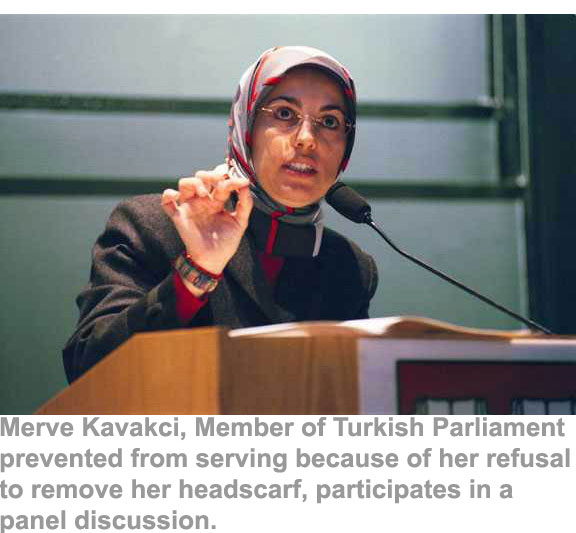 |
Here are some examples of the symbolism of veiling:
Algeria
Pre 1830
-Common custom is for women to veil. Public dress typically consists of
a large scarf covering the head, hair, and upper body, a face veil, and
baggy pants.
1830
-The French land in Algeria and enforce French law and social plan,
attempting to stamp out Algerian culture all together.
-Algerians are forbidden to study their own language (Arabic).
-Algerians are excluded from any desirable employment opportunities.
-The French monopolize the best land to cultivate crops that Algerians
don't consume (such as vineyards for wine).
Late 1800s
-The French White Fathers begin strict missionary proselytizing.
-Some Algerian women are persuaded to unveil as a means of controlling,
uprooting, and Westernizing.
-The Algerian women who unveil and begin wearing Western clothing are
criticized by the French and looked down upon as loose women.
Early 1900s
-Algerians fervently resume veiling as a protest of French occupation.
The veil becomes a symbol of revolution, national and cultural pride,
and freedom.
1954
-Algerians form the National Liberation Front (FLN) and begin a
revolution.
1958-1960
-The French Secret Army Organization (OAS) systematically rapes
Algerian women.
-Male and female Algerian Revolutionaries are taken into captivity and
tortured.
-Women act as nurses and food providers, conceal weapons beneath their
veils, and secretly sustain the Revolution after all the male heads of
the FLN are arrested.
1962
Algerian Independence.
For further views on the Algerian Revolution, we suggest the film The Battle of Algiers, directed by Gill Potencorvo, 1966, and http://www.arab.net/algeria/history/aa_french.htm
Iran
Pre
1939
-Common custom is for women to veil. Women in more conservative areas
wear full chador. Other women wear variations of the hijab.
1939
-Reza Shah Palevi, ruler of Iran, bans the veil as a statement of
modernization.
-Government officials are ordered to rip veils off of women in the
streets.
-Women who chose to veil as an expression of privacy, pride, and
freedom are forced to stay home or hide in the shadows of buildings in
fear of being caught.
1941-1979
-Reza Shah looses power.
-Veiling is once again permitted.
-Many women wear head veils rather than the full chador.
-Religious and conservative women wear the chador.
-Socially, the veil is perceived as "behind the times," and many do not
veil as a statement of fashion.
1950s
-The CIA stages a coup against the democratically elected president for
fear of losing oil rights in Iran and to prevent the spread of
communism..
-The Shah is instated as a puppet to the US.
-In anger against US involvement in their government, the Iranian
people take allegiance to Ayatollah Khomeini.
1979
-The Iranian Revolution.
-The Iranian public, and lower-class women in particular, riot and
protest in the streets.
-In one day, 2.4 million Iranians march peacefully, demanding an end to
the Shah's reign.
-Women begin to wear full chadors as an anti-Western symbol, and to
show allegiance to the Revolution.
-Ayatollah Khomeini encourages women to engage in the politics of
Revolution.
-Ayatollah Khomeini regains power.
1983
-The government encourages women to vote, become educated, and join the
mobilization in the war against Iraq.
-Strict public segregation of the sexes is enforced.
-Public veiling is required in its strictest form, the chador.
-Every last strand of women's hair must be covered. Makeup, colorful
veils, and anything considered attractive is forbidden because they
distract from female piousness and spirituality.
-The veil erases visible traces of class distinction, which was a root
issue of the Revolution (much like the French Revoluton.)
-Government officials arrest and sometimes flog unveiled women found in
the streets.
Today
-Democratically elected President Komeni is in power, working in
conjunction with a board of religious clerics.
-More Iranian women are literate than men, a vast jump from the 1970s,
when there was a 60% female illiteracy rate in Iran.
-Women occupy jobs in every branch of the Iranian government.
-Veiling is required, but in hijab rather than chador
form.
| -Underneath the veil, women wear whatever they like, including trendy clothing and makeup. This picture of two Iranian women is an example. | 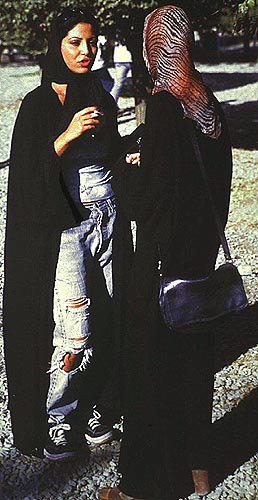 |
-The color of girls
school uniforms has been changed to green. Green is symbolic of Islam
and has recently come to symbolize the reform movement.
-On the anniversary of Khatami's election, thousands of women wear
green veils to show approval.
Afghanistan
Pre 1994
|
-There are no laws enforcing veiling in Afghanistan, but most women in rural areas veil voluntarily.
|
 |
1994
-After the war with the Soviet Union, Afghanistan is left in
devistation with no government.
-The Taliban takes power under Mullah Mohammed Omar.
-The Taliban plans to build an ideal Islamic society and restore peace.
1996
-The Taliban seizes Kabul, Afghanistan's capital, and begins to enforce
the strictest interpretation of Shari'ah Islam ever seen. Many Muslims
today believe this is not true Islam.
-Women are forbidden to go to school or work and are relegated to the
home.
-Men are required to grow long beards.
-The veil is strictly enforced in full burqa form.
-Windows of residences are painted white so that passersby can't look
inside.
-Women who have never veiled in their lives have trouble adapting to
the veil.
2001
-The Taliban falls under pressure from the US army.
-Long lines of Afghani men wait outside of barbershops to shave their
beards.
-Some women cast aside their veils as an anti-Taliban symbol.
-Some women continue to veil.
For more information on Afghanistan, we suggest http://www.channel4.com/life/microsites/A/afghanistan/
The United
States
-Muslim
women in the US have always been free to veil or not to veil, according
to personal choice.
-Many women veil voluntarily for privacy and freedom, or as a proud
symbol of Islam.
-After the attacks of September 11th, American Muslims of every age and
gender report hate crimes and harassment ranging from verbal abuse,
threats, and vandalism, to physical assault, murder, and possibly rape.
-The Muslim Women's league urges American women not to veil in public
for reasons of safety, reminding them that the point of Islamic dress
is to help avoid harassment:
"The strength of one's faith is not manifested in one's outward appearance, but rather in the courage of one's actions to justice and truth in surrendering to God… Individual life and personal safety take precedence over normal Islamic rules. As established in a primary priciple of Islamic jurisprudence, 'necessity renders the forbidden permissible,' (Said Ramadan, Islamic Law: Its Scope and Equity 71 (1970)). http://www.mwlusa.org/hijab_dengerous_times
Canada and France
-In Canada and France,
Muslim women are free to veil or not to veil in the streets, according
to personal choice.
-Wearing a headscarf in public schools is forbidden because it is seen
as challenging Canadian/French patriotism.
The veil can be a symbol of empowerment or oppression whether it is enforced or forbidden. If veiling is forced, then it becomes a symbol of something more deep rooted that challenges public conceptions of Islam. The ultimate goal of Islam is surrender to God, so veiling or not veiling is less important than the underlying sentiment it symbolizes.
Annotated Bibliography
Weblinks:
1) http://www.maryams.net/articles_veil01.shtml
Muslim Feminists and the Veil
Research project looking at responses to issues of gender equality and
veiling from the perspective of Muslim feminists. Addresses the
question, "To veil or not to veil?"
2) http://www.islamfortoday.com/women.htm
Information, articles, and links on a variety of topics concerning
women in Islam. Several articles regarding the veil as a symbol of
oppression or liberation.
3) http://www.albalagh.net/women/hijab.shtml
Veil: The View From the Inside
Nakata Khaula's article about her experiences as a Japanese convert to
Islam who has chosen to veil.
4) http://seattletimes.nwsource.com/news/nation-world/crisis/theregion/veils.html
Interpreting Veils
Detailed drawings and explanations of the various forms of veils such
as the burka, chador, and hijab.
5) http://www.mwlusa.org/hijab_dangerous_times
Muslim Dress in Dangerous Times
As a response to the September 11, 2001 terrorist attacks on the World
Trade Center in New York City, the Muslim Women's League recommends
Muslim women residing in the United States not wear their veil if they
feel threatened. Discusses Islam beliefs regarding the veil and how
these women are not "bad Muslims" if they choose not to wear the veil.
6) http://www.nyartsmagazine.com/57/beyondourveils.html
Beyond Our Veils
Discusses the installation art work of Roya Ghiasy in Venice, Italy. As
a Muslim artist from Afghanistan, Ghiasy attempts to challenge Western
misconceptions about the veil, suggesting that the veil can be
liberating.
7) http://www.rferl.org/nca/features/2000/03/F.RU.000314135118.html
World: Some Muslim Women Consider Their Veils Liberating
Article about cultural identify of Muslim artist Roya Ghiasy and how
this identity affects her artwork. The author questions cultural
perceptions and how a culture views itself and how outsiders understand
it.
8) The following websites
discuss contemporary veiling:
http://www.arab.net/algeria/history/aa_french.htm
(Algeria)
http://www.channel4.com/life/microsites/A/afghanistan/
(Afghanistan)
http://www.mwlusa.org/hijab_dangerous_times
(United States)
Books/Articles:
1) Mernissi, Fatima
(1991) The Veil and the Male Elite: A Feminist Interpretation of
Women's Rights in Islam. Lakeland, Mary Jo, tans. Reading, MA:
Addison-Wesley.
Mernissi seeks to identify the sources of prevalent negative attitudes
regarding women within the religionof Islam. She concludes that such
views stem from manipulation of hadiths, misinterpretation of
the Qur'an, and male elitist authority as opposed to the actual tenets
of Islam.
2) El Guindi, Fadwa
(1999) Veil: Modesty, Privacy, and Resistance. Oxford, New
York: Berg.
The author challenges the stereotypical Western view to the meaning of
the veil and veiling. She attempts to disentangle the confusions that
exist between languages regarding the veil. Her analysis illustrates
the layers of meanings that are mixed with veiling in the past and
present, in Muslim and non-Muslim countries, and describes the various
dimensions on which the veil can be interpreted.
3) Alloula, Malek (1986) The
Colonial Harem. Minneapolis: University of Minnesota Press.
Displays postcards of supposedly Algerian women produced and sent by
the French in Algeria to their homeland during France's colonization of
Algeria in the first three decades of the twentieth century. The author
enables the reader to observe the influence and implications of the
French's "colonial gaze" in their representation of Algerian women.
Barbara Harlow's introduction discusses the complex issues that
underlie the representation of the "other" as it relates to Algeria and
the West.
4) Shirazi, Faegheh
(2001) The Veil Unveiled: The Hijab in Modern Culture. University
Press of Florida
This provocative book demonstrates that the veil holds within its folds
a versatility that goes beyond current clichés and homogenous
representations. Whether seen as erotic or as romantic, a symbol of
oppression or a sign of piety, modesty, or purity, the veil carries
thousands of years of religious, sexual, social, and political
significance.
5) Entekhabi-Fard,
Camelia (Auguest 2001) "Behind the Veil." Mother Jones.
Discusses Iran's mandatory veiling practice and how Westerners see this
practice as a symbol of repression despite the freedom that many
Iranian women feel they have gained through the wearing of the hijab.